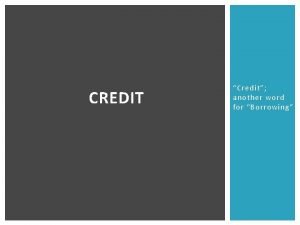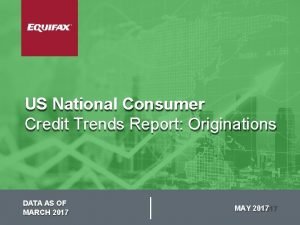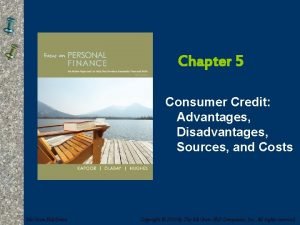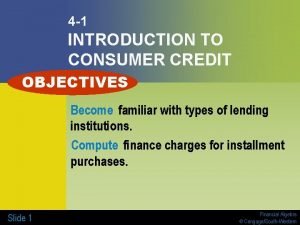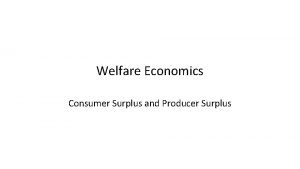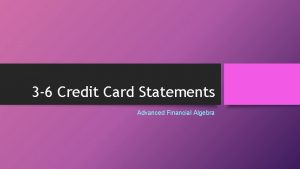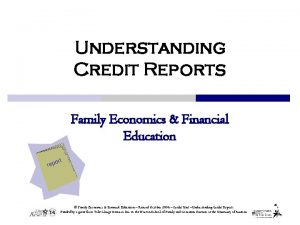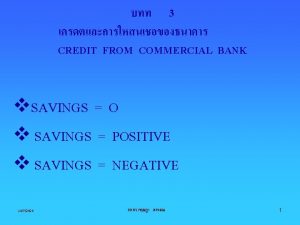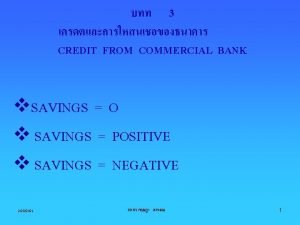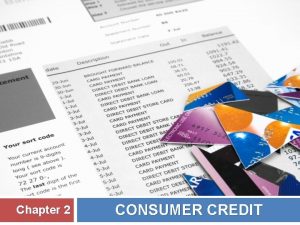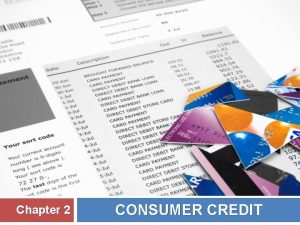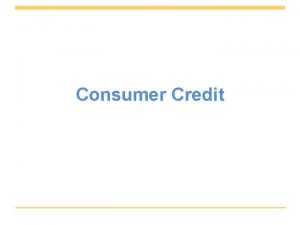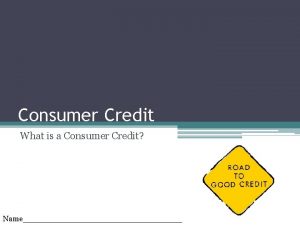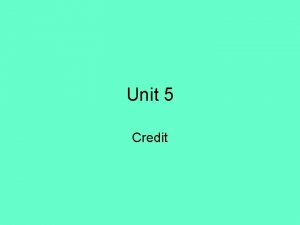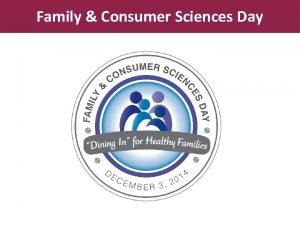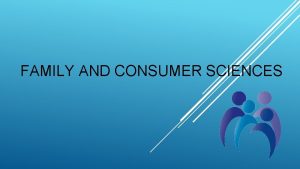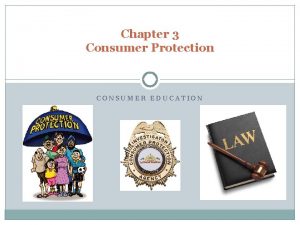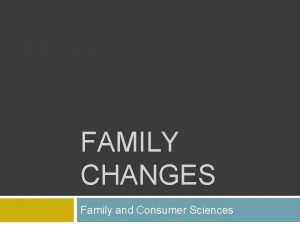Family Economics Financial Education Sources of consumer credit























- Slides: 23

Family Economics & Financial Education Sources of consumer credit © Family Economics & Financial Education – Revised October 2004 – Credit Unit – Selecting a Credit Card Funded by a grant from Take Charge America, Inc. to the Department of Health and Human Development at Montana State University – Bozeman 1. 4. 1. G 1

Family Economics & Financial Education Types of Borrowing • Secured Loan • Unsecured Loan © Family Economics & Financial Education – Revised October 2004 – Credit Unit – Selecting a Credit Card Funded by a grant from Take Charge America, Inc. to the Department of Health and Human Development at Montana State University – Bozeman 1. 4. 1. G 1

Family Economics & Financial Education 1. 4. 1. G 1 Statistics • 92% of college students have a credit card by their sophomore year • 1 out of every 5 college students owes between $3, 000 and $7, 000 in credit card debt • Almost half (47%) of all college students carry four or more credit cards (Source: http: //www. fcs. iastate. edu/financial) © Family Economics & Financial Education – Revised October 2004 – Credit Unit – Selecting a Credit Card Funded by a grant from Take Charge America, Inc. to the Department of Health and Human Development at Montana State University – Bozeman

Family Economics & Financial Education 1. 4. 1. G 1 Secured Loans A Secured Loan is backed by something of value pledged to ensure payment. (house) § § § Property pledged to back a loan is collateral Safe for the lender Not safe for borrower Most secured loans are installment loans. Installment loans are paid back in a certain number of payments. (car loan) also called closed-end loans. © Family Economics & Financial Education – Revised October 2004 – Credit Unit – Selecting a Credit Card Funded by a grant from Take Charge America, Inc. to the Department of Health and Human Development at Montana State University – Bozeman

Family Economics & Financial Education 1. 4. 1. G 1 Unsecured loans are not backed by any collateral. § Granted credit based on creditworthiness. § Generally will pay a higher interest rate than a secured loan. Lender is taking a bigger risk. § Most credit cards are unsecured loans because they are unspecified amounts up to the consumers credit limit. (sometimes referred to as open-end credit because the balance does not have to paid by a specific date). © Family Economics & Financial Education – Revised October 2004 – Credit Unit – Selecting a Credit Card Funded by a grant from Take Charge America, Inc. to the Department of Health and Human Development at Montana State University – Bozeman

Family Economics & Financial Education 1. 4. 1. G 1 Types of Credit Cards • Regular Charge Accounts • You must pay your balance in full within a specified period. – No interest because you are not borrowing money • Entire balance must be repaid in 30 days. • American Express, Diner’s Club and some Department Stores • Revolving Charge Accounts • Most common credit card • Allows you to carry the balance from one month to the next. • You can pay any amount over the minimum each © Family Economics & Financial Education – Revised October 2004 – Credit Unit – Selecting a Credit Card Funded by a grant from Take Charge America, Inc. to the Department of Health and Human Development at Montana State University – Bozeman

Family Economics & Financial Education 1. 4. 1. G 1 Types of Credit Cards cont. • Bank Credit Cards • Flexible Accounts • Accepted Anywhere • Available from a financial institution (commercial bank, credit union) with a service provider (VISA, Master. Card)

1. 4. 1. G 1 Family Economics & Financial Education Fees continued • Fair Truth in Lending Act • Information required by law to inform consumer of all costs associated with use of a credit card Annual Percentage Rate for Purchases 19. 9% Grace Period for Purchases Not less than 25 days Minimum Finance Charges $. 50 when a finance charge at a periodic rate is charged Balance Calculation Method for Purchases Average daily balance method (including new purchases) Annual Fees $20 per year Transaction Fees for Cash Advances 2% with a minimum fee of $3 Late Payment Fees $29 © Family Economics & Financial Education – Revised October 2004 – Credit Unit – Selecting a Credit Card Funded by a grant from Take Charge America, Inc. to the Department of Health and Human Development at Montana State University – Bozeman

1. 4. 1. G 1 Family Economics & Financial Education Annual Percentage Rate for Purchases 19. 9% Grace Period for Purchases Not less than 25 days Minimum Finance Charges $. 50 when a finance charge at a periodic rate is charged Balance Calculation Method for Purchases Average daily balance method (including new purchases) Annual Fees $20 per year Transaction Fees for Cash Advances 2% with a minimum fee of $3 Late Payment Fees $29 • Annual Percentage Rate (APR) – Interest rate charged for amount borrowed in terms of per dollar per year © Family Economics & Financial Education – Revised October 2004 – Credit Unit – Selecting a Credit Card Funded by a grant from Take Charge America, Inc. to the Department of Health and Human Development at Montana State University – Bozeman

1. 4. 1. G 1 Family Economics & Financial Education Grace Period Annual Percentage Rate for Purchases 19. 9% Grace Period for Purchases Not less than 25 days Minimum Finance Charges Balance Calculation Method for Purchases $. 50 when a finance charge at a periodic rate is charged Average daily balance method (including new purchases) Annual Fees $20 per year Transaction Fees for Cash Advances Late Payment Fees 2% with a minimum fee of $3 • Grace Period – Amount of time allowed before finance charges are applied © Family Economics & Financial Education – Revised October 2004 – Credit Unit – Selecting a Credit Card Funded by a grant from Take Charge America, Inc. to the Department of Health and Human Development at Montana State University – Bozeman $29

1. 4. 1. G 1 Family Economics & Financial Education Minimum Finance Charges Annual Percentage Rate for Purchases 19. 9% Grace Period for Purchases Not less than 25 days Minimum Finance Charges Balance Calculation Method for Purchases $. 50 when a finance charge at a periodic rate is charged Average daily balance method (including new purchases) Annual Fees $20 per year Transaction Fees for Cash Advances Late Payment Fees 2% with a minimum fee of $3 • Minimum Finance Charge – Minimum amount charged for card use © Family Economics & Financial Education – Revised October 2004 – Credit Unit – Selecting a Credit Card Funded by a grant from Take Charge America, Inc. to the Department of Health and Human Development at Montana State University – Bozeman $29

1. 4. 1. G 1 Family Economics & Financial Education Balance Calculation Method Annual Percentage Rate for Purchases 19. 9% Grace Period for Purchases Not less than 25 days Minimum Finance Charges $. 50 when a finance charge at a periodic rate is charged Balance Calculation Method for Purchases Average daily balance method (including new purchases) Annual Fees $20 per year Transaction Fees for Cash Advances Late Payment Fees 2% with a minimum fee of $3 $29 • Balance Calculation Method – Method used to determine balance for finance charges © Family Economics & Financial Education – Revised October 2004 – Credit Unit – Selecting a Credit Card Funded by a grant from Take Charge America, Inc. to the Department of Health and Human Development at Montana State University – Bozeman

Family Economics & Financial Education 1. 4. 1. G 1 Balance Calculation Method cont. • Balance Calculation Method § Average daily balance – You pay interest on the average balance owed during the billing cycle. § Adjusted balance – You pay interest on the opening balance after subtracting the payment or returns made during the month. § Previous balance – You pay interest on the opening balance, regardless of the payments made during the month. § Past-due balance – No finance charge is added if the full payment is received within the grace period. © Family Economics & Financial Education – Revised October 2004 – Credit Unit – Selecting a Credit Card Funded by a grant from Take Charge America, Inc. to the Department of Health and Human Development at Montana State University – Bozeman

1. 4. 1. G 1 Family Economics & Financial Education Annual Fees Annual Percentage Rate for Purchases 19. 9% Grace Period for Purchases Not less than 25 days Minimum Finance Charges Balance Calculation Method for Purchases $. 50 when a finance charge at a periodic rate is charged Average daily balance method (including new purchases) Annual Fees $20 per year Transaction Fees for Cash Advances Late Payment Fees 2% with a minimum fee of $3 $29 • Annual Fees – Yearly charge for credit card ownership © Family Economics & Financial Education – Revised October 2004 – Credit Unit – Selecting a Credit Card Funded by a grant from Take Charge America, Inc. to the Department of Health and Human Development at Montana State University – Bozeman

1. 4. 1. G 1 Family Economics & Financial Education Cash Advances Annual Percentage Rate for Purchases 19. 9% Grace Period for Purchases Not less than 25 days Minimum Finance Charges $. 50 when a finance charge at a periodic rate is charged Balance Calculation Method for Purchases Average daily balance method (including new purchases) Annual Fees $20 per year Transaction Fees for Cash Advances Late Payment Fees 2% with a minimum fee of $3 • Cash Advance Transaction Fees – Cash withdrawal fees © Family Economics & Financial Education – Revised October 2004 – Credit Unit – Selecting a Credit Card Funded by a grant from Take Charge America, Inc. to the Department of Health and Human Development at Montana State University – Bozeman $29

1. 4. 1. G 1 Family Economics & Financial Education Late Payment Fees Annual Percentage Rate for Purchases 19. 9% Grace Period for Purchases Not less than 25 days Minimum Finance Charges $. 50 when a finance charge at a periodic rate is charged Balance Calculation Method for Purchases Average daily balance method (including new purchases) Annual Fees $20 per year Transaction Fees for Cash Advances Late Payment Fees 2% with a minimum fee of $3 • Late Payment Fees – Penalty fee for payments not made by the due date © Family Economics & Financial Education – Revised October 2004 – Credit Unit – Selecting a Credit Card Funded by a grant from Take Charge America, Inc. to the Department of Health and Human Development at Montana State University – Bozeman $29

Family Economics & Financial Education Opening a Credit Account 1. 2. 3. 4. 5. Applicant completes a credit application Lender conducts a credit investigation Applicant is given a credit rating Lender accepts or denies the credit request If accepted, applicant evaluates the credit card details 6. Applicant accepts or refuses credit terms © Family Economics & Financial Education – Revised October 2004 – Credit Unit – Selecting a Credit Card Funded by a grant from Take Charge America, Inc. to the Department of Health and Human Development at Montana State University – Bozeman 1. 4. 1. G 1

Family Economics & Financial Education 1. 4. 1. G 1 Understanding the Bill • Minimum Payment Due – The minimum amount to be paid § If this amount is paid and a balance is left on the account, additional finance charges will be included in the following month’s balance • Past Due Amount – The required amount not paid before the due date • Due Date – The day by which the company requires a payment to be made • New Balance – The total amount owed on a credit card © Family Economics & Financial Education – Revised October 2004 – Credit Unit – Selecting a Credit Card Funded by a grant from Take Charge America, Inc. to the Department of Health and Human Development at Montana State University – Bozeman

Family Economics & Financial Education 1. 4. 1. G 1 Understanding the Bill cont. • Credit Line – The maximum amount of charges allowed to an account • Closing Date – Last day for transactions to be reported on the statement • Charges, Payments, and Credits – The transactions which occur with the use of a credit card • Finance Charge – Charges assessed for credit card use © Family Economics & Financial Education – Revised October 2004 – Credit Unit – Selecting a Credit Card Funded by a grant from Take Charge America, Inc. to the Department of Health and Human Development at Montana State University – Bozeman

Family Economics & Financial Education 1. 4. 1. G 1 Using a Credit Card Properly • Only use a card when there is no doubt about ability to pay off the charges at the end of the billing cycle • Record all expenses and keep receipts • Check credit statement for errors • Always pay off balance completely and timely © Family Economics & Financial Education – Revised October 2004 – Credit Unit – Selecting a Credit Card Funded by a grant from Take Charge America, Inc. to the Department of Health and Human Development at Montana State University – Bozeman

Family Economics & Financial Education 1. 4. 1. G 1 20 -10 Rule Never borrow more than 20% of your yearly net income. If you earn $400 a month after taxes, then your net income in one year is: 12 * $400 = $4, 800 Calculate 20% of your annual net income to find your safe debt load: $4, 800 * 20% = $960 You should never have more than $960 of debt outstanding. * Housing debt should not be included as part of the 20% © Family Economics & Financial Education – Revised October 2004 – Credit Unit – Selecting a Credit Card Funded by a grant from Take Charge America, Inc. to the Department of Health and Human Development at Montana State University – Bozeman

Family Economics & Financial Education 1. 4. 1. G 1 20 -10 Rule Monthly payments should not exceed 10% of your monthly net income. If your take-home pay is $400 a month: $400 * 10% = $40 Your total monthly debt payments should not total more than $40 per month. * Housing debt should not be included as part of the 20% © Family Economics & Financial Education – Revised October 2004 – Credit Unit – Selecting a Credit Card Funded by a grant from Take Charge America, Inc. to the Department of Health and Human Development at Montana State University – Bozeman

Family Economics & Financial Education Safety Tips • Sign card with signature and “Please See ID” • Do not leave cards lying around • Close unused accounts in writing and by phone, then cut up the card • Do not give out account number unless making purchases • Keep a list of all cards, account numbers, and phone numbers separate from cards • Report lost or stolen cards promptly © Family Economics & Financial Education – Revised October 2004 – Credit Unit – Selecting a Credit Card Funded by a grant from Take Charge America, Inc. to the Department of Health and Human Development at Montana State University – Bozeman 1. 4. 1. G 1
 Fefe curriculum
Fefe curriculum Family economics and financial education worksheet answers
Family economics and financial education worksheet answers Fefe curriculum
Fefe curriculum Food web vs food chain
Food web vs food chain Print sources and web sources
Print sources and web sources Water management importance
Water management importance Sources of credit
Sources of credit This can be avoided by giving credit where credit is due.
This can be avoided by giving credit where credit is due. Equifax national consumer credit trends report
Equifax national consumer credit trends report What are the disadvantages of consumer credit
What are the disadvantages of consumer credit 4-1 introduction to consumer credit
4-1 introduction to consumer credit 3-1 introduction to consumer credit
3-1 introduction to consumer credit Consumer credit of the quad cities
Consumer credit of the quad cities Primary consumer
Primary consumer Cengage
Cengage Consumer behaviour research process
Consumer behaviour research process Analyzing consumer markets and buyer behavior
Analyzing consumer markets and buyer behavior Types of buyer behavior
Types of buyer behavior Consumer surplus economics
Consumer surplus economics Consumer surplus formula
Consumer surplus formula Economics and business economics maastricht
Economics and business economics maastricht What is mathematical economics
What is mathematical economics Legume family
Legume family 3-6 credit card statement answers
3-6 credit card statement answers






